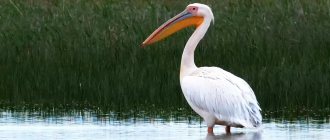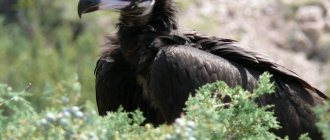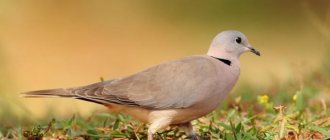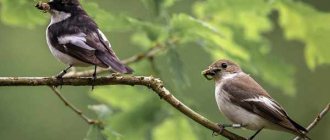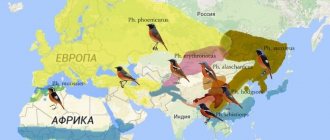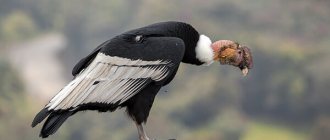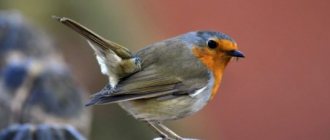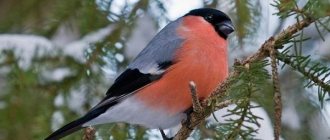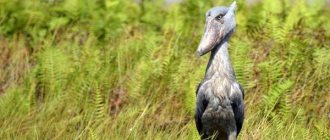Albatrosses are, in fact, rather large seabirds, covered in all sorts of legends. Since ancient times, it was believed that a meeting with this bird would definitely bring prosperity to a person’s home. This was especially true for sailors who were glad to see these birds next to their ship. Sailors believed that albatrosses were the souls of dead sailors.
People still believe that you cannot go unpunished if you harm these birds. These seabirds have been living their lives for thousands of years without showing any aggression, either towards the outside world or towards humans.
Varieties
Photo: Birds Wiki - Fandom
There are 14 species of albatross, ornithologists often divide them into 3 main groups:
- Great albatrosses . This includes 3 species, all with a wingspan of about 3 meters on average: the wandering, royal and Amsterdam albatross.
- Mollymawks . This group includes 9 smaller species with a wingspan averaging 2.2 meters: short-tailed, dark-backed, black-footed, billowy, black-browed, yellow-crested, grey-headed, shy and Buller's albatross.
- Sooty albatrosses. Includes 2 species with a wingspan of 1-2 meters on average: the dark-backed smoky albatross and the light-backed smoky albatross.
Origin
At least 8 species of fossil albatross birds have been discovered. The earliest fossils date back to about 60 million years ago , meaning the ancestors of modern albatrosses appeared in the Cenozoic era.
Photo: UC Berkeley News
Fossil albatrosses have been found in England, the United States and Japan, indicating that they once had a more northerly distribution , which ornithologists believe ended 20 million years ago (when the Pacific and Atlantic oceans ceased to occur in the area of modern Panama ).
Surprisingly, none of the extinct albatrosses were as large as the modern wandering albatross, the largest member of the family Diomedeidae.
Reproduction
When albatrosses are about seven years old, they begin to look for a mate. They perform complex mating dances to attract attention. The wings are extended, the birds shake their beaks, moan and wheeze, and then throw their heads back.
Interesting fact : albatrosses only give birth to chicks on islands where there is no native mammal population. Introduced mammals such as rats or mice are decimating albatross populations on some islands. Albatross chicks are left unprotected while their parents fly off to remote fishing destinations.
Albatross
If an albatross cannot perform the dance correctly, it may be a sign that it is sick or injured and is not fit to be a parent. Albatross mates for life. They will meet to procreate every two years.
Interesting fact : the name albatross originally comes from the Portuguese word - gannet, alcatraz, which in turn comes from the Arabic word meaning "diver".
Character traits
Their incredible flying abilities are more than just big wings and skill. The anatomy of albatrosses includes several unique features that help them in their lives, much of which is spent on constant flight.
Photo: The Spruce
Anatomical features
Albatrosses have their own version of pitot tubes—devices that allow airplane pilots to measure airspeed—in the form of two tubes running down the sides of their beaks.
Albatrosses can lock their wings in place using a special tendon when their wings are fully extended. This position helps the birds glide in the air flow without any serious energy expenditure. As a result, the albatross's heart rate during flight is almost as low as at rest.
Albatrosses do not have toes on their hind feet - they do not need them, since they spend 80% of their lives at sea. This is probably why these birds have adapted to drink sea water . The salt passes through their bloodstream and is excreted through a special gland above their nasal passages.
Photo: Stuff.co.nz
Plumage
The plumage of adult albatrosses can be white, gray or black. It is noteworthy that over time the feathers become lighter . Absolutely white coloration is characteristic of royal (at any age) and wandering (at sexual maturity) albatrosses. Dark brown plumage distinguishes the Amsterdam species. Female representatives and young animals of other varieties have predominantly ash-black plumage.
Lifestyle and habitat
The life of birds is eternal sea voyages, air travel over thousands of kilometers. Albatrosses often accompany ships. Having overtaken the ship, they circle above it, then seem to hover over the stern, waiting for something edible. If the sailors feed the companion, the bird descends to the water, collects food and again follows the stern.
Calm weather is the time for albatrosses to rest. They fold their large wings, sit on the surface, and sleep on the surface of the water. After calm, the first gusts of wind help them rise into the air.
Near ships, they readily use suitable masts and ship decks to gain strength. Birds prefer to take off from elevated places. Cliffs and steep slopes are ideal places to go on a trip.
Wind jets and the reflection of air currents from the slopes of the waves support the birds on takeoff and accompany them in turns at the hunting and feeding sites. Free soaring, inclined and dynamic, with wind speeds of up to 20 km/h helps the albatross cover 400 km in a day, but this distance does not reflect the limit of their capabilities.
Air currents and bird speeds of up to 80-100 km/h allow them to move a thousand kilometers per day. Ringed birds flew around the globe in 46 days. Windy weather is their element. They can stay in the ocean of air for hours without making a single movement of their wings.
Clouded albatross
Sailors associate the appearance of albatrosses and related petrels with the approach of a storm; they are not always happy about such natural barometers. In places rich in food, huge albatross coexist peacefully with small birds without any conflicts: gulls, gannets, petrels. Huge flocks of free birds are created without a social structure. In other places, outside the nesting area, albatrosses live alone.
The gullibility and meekness of birds allows a person to get close. This feature affects and often kills birds. They have not developed the skill of defense, since they have long nested away from predators.
The territories where the albatross lives are vast. In addition to the Arctic Ocean, birds are found in almost all seas of the Earth’s northern hemisphere. Albatrosses are called Antarctic inhabitants.
Albatross bird
Some species have moved to the Southern Hemisphere thanks to humans. Flight through the calm sector of the equator is practically impossible for them, with the exception of individual albatrosses. Albatrosses do not have seasonal migrations. After completing the breeding stage, the birds fly to related natural areas.
Geographical range
Of the 14 species of albatross, 3 species live in the Northern Hemisphere. Two of them, the dark-mantled and black-footed albatross, are typically found only in the Hawaiian Leeward Island chain. Although the dark-mantled albatross also breeds on the Japanese island of Torishima.
Torishima is the only known breeding site for the short-tailed albatross. This bird has had a very difficult last century. First, its population was nearly wiped out by feather traders in the late 1800s. Then in 1939 and 1941, volcanic eruptions destroyed all surviving birds and they were thought to have gone extinct. However, in 1953 it was discovered that the short-tailed albatross was nesting here again.
The juveniles of these long-lived birds are believed to have survived being at sea in 1939 and 1941, only returning to the island at maturity several years later when it was safe to nest again. The species is not currently on the critical list, but is still endangered.
The remaining 11 species of albatrosses are largely confined to the Southern Hemisphere. Northern and southern populations are unchecked due to a virtually windless part of the ocean at the equator, called the equatorial depression , which creates an effective barrier for birds dependent on wind for long-distance flights.
Enemies
The mortality rate among these birds is very low. In the open ocean, there is practically no threat to the albatross. Danger arises only during nesting, and even then very rarely. There are no predators on the islands. The only threat can arise from feral cats brought by people and abandoned on uninhabited land, or from rats arriving on the islands from ships. These animals can attack both the bird hatching the egg and the chick. In the 20th century, humans were a threat to the albatross. He mercilessly exterminated large birds for their feathers, which were used for ladies' hats. Today, almost all species of albatrosses are protected by the World Conservation Union.
Lifestyle
Albatrosses live a primarily pelagic (solely marine) life, returning to land only to breed and care for their chicks. Considering how relaxing albatross flight can be, it is not surprising that they spend very little time on terra firma. Birds spend most of their lives flying in the vast expanses of ocean air. And they choose remote islands for nesting.
Flight Features
Two species - the wandering albatross and the southern royal albatross - share the title of bird with the largest wingspan in the world. On average, their wings reach three meters from tip to tip. The longest wings recorded were almost four meters.
Photo: HowStuffWorks
Birds use these enormous wings to fly incredible distances. Wandering albatrosses are known to travel 120,000 kilometers during their migration across the Antarctic (Southern) Ocean.
Great albatrosses, the largest members of the albatross family, are enormous. Flapping their massive wings requires a lot of effort, so they do it as little as possible. Great albatrosses are designed for gliding flight . In fact, their anatomy is so well designed that in the air they will glide an impressive 22-23 meters for every meter of height they lose while floating. These seabirds can fly several kilometers with just one flap of their wings!
Birds also use a technique called dynamic soaring , in which they "float" along the boundary between two air masses. This allows them to float freely for long periods of time with little or no effort except for a few course corrections.
Albitros lifestyle
The albatross feels great at sea in any weather. On the water, the largest bird in the world floats like a float, thanks to its airy, waterproof plumage. Very often, an albatross may not go onto land for several weeks, even sleeping on the water.
Huge wings give him the ability to stay in the air, almost without flapping, but using the power of the wind, like a glider. He has a very interesting flying technique. It flies by making periodic descents, during which it picks up speed, and then, on the oncoming air flow, soars up, without even flapping its wings, but only changing the angle of their inclination. Usually the albatross does not rise high into the sky; it tries to stay about 10-15 meters from the water, since at this height the air flow is the most powerful. Thanks to this method, he can soar over the waves for a long time, almost without moving his wings.
However, with such huge wings, it is not always convenient for the albatross to take off. Calm weather on land or calm seas are a disastrous proposition for him. In such weather, he is forced to simply sway on the waves and doze off, waiting for the wind to blow. On land, he specifically chooses a place on the coastal slope, much like paragliders do.
Eating habits
Albatrosses feed in the open ocean mainly on squid, krill, crustaceans and schooling fish. In general, these are opportunistic hunters, eating almost everything they can grab.
Photo: American Bird Conservancy
These seabirds use different hunting tactics :
- diving under schools of fish (to a depth of 7 meters) to drive them to the surface of the water, where they are easier to catch;
- stealing food from other seabirds such as the thick-billed petrel;
- following fishing boats in hopes of dining on handouts or food scraps.
Sometimes they get so full that they lose the ability to fly, and they just have to float on the water. And grey-headed albatrosses are generally ready to fly long distances for food, even during the breeding season, sometimes making flights up to 13,000 km!
What do they eat?
Regardless of the species, whether wandering or royal albatross, birds feed mainly on the following food :
- Fish;
- Small squid;
- Small octopuses;
- Krill;
- Small crustaceans.
In addition, representatives of these birds can also eat dead inhabitants of the waters, of which there are quite a lot in the vast seas and oceans.
Albatrosses often settle into the wake of ships and vessels, accompanying them for a long time, absorbing all the waste that is thrown into the sea or ocean. And if on the way the birds come across some kind of floating base for processing marine products, then albatrosses are ready to fly for such ships for months over several thousand miles. However, this way of life is commonplace for individuals. It’s not for nothing that the wandering albatross received this name. These birds are constantly on the move.
Reproduction
Courtship
Albatrosses are famous for their eloquent courtship, which includes ritual dances and - in some species, such as the dark-mantled clouded albatross - daring flight chases , with the pursuing bird mimicking the leader's every move.
Mating dances are a set of sequential movements with a response from the partner. Quite a lot of research has been carried out to decipher the language of behavioral mannerisms of albatrosses, as a result of which it was revealed that most species are characterized by three ritual courtship dances :
- the bird stands with its wings open - or not - and shakes its head, rising up, making one loud clap of its hands. When the head is pointed upward (at an angle of 45 to 90 degrees), the albatross makes a series of loud sounds while the head and beak remain motionless.
- the bird lunges forward with its leg and loudly claps its beak, then tilts its head to one side and rests it on the top of its leg or preens.
- an upright bird lowers its neck and head to its feet. She can throw her head back between her legs. This action is often performed in pairs facing each other.
Once they choose a mate, albatrosses remain together until death, meaning couples can form alliances of 50 years or more. As romantic as it may sound, albatrosses are not strictly monogamous birds.
Breeding season
Albatrosses mate for life, although the pair will break up if breeding is unsuccessful for several years. Large albatross species will begin breeding at 15-16 years of age, although some may enter the reproductive process at a younger age. Smaller species take about 7 years to reach maturity.
Albatrosses breed in colonies on sea islands. Southern species build cone-shaped nests from peat, feathers, soil and plants on flat coastal meadows, cliffs or steep slopes. The nests can be up to 60 cm high. A small depression is made in the middle, where a single white egg is placed. Northern species hatch eggs on bare ground or sand.
Photo: Smithsonian Magazine
These monogamous birds spend a lot of time and effort raising their young, laying one egg every two years, usually between September and early November. Both parents share the responsibilities of incubating the egg, taking turns keeping it warm.
- Age of sexual or reproductive maturity: 7 to 16 years
- Mating system: monogamy
- Breeding interval: once every two years
- Mating season: autumn
Cubs development
They have the longest incubation period among birds. Incubation lasts 69-75 days - in larger species the process takes longer than in smaller species. The egg hatches around the end of the year, and the young take about 4 days to completely emerge from their shell. Once the chick hatches, the parents spend several more months on land caring for their offspring before all three can head to sea together.
Photo: Oregon State University
Plumage takes between 120 days (black-browed albatross) and 275 days (wandering albatross). This long fledging time explains why virtually all species breed only once every two years.
- Number of eggs in a clutch: one egg
- Incubation period: average 10 weeks
Albatross: description
Albatrosses are birds belonging to the order Petrels and the family of seabirds. According to experts, this species of birds is quite ancient. The remains of birds found by archaeologists indicate that they soared over the vastness of the world's oceans about 30 million years ago. Scientists also know about the existence of close relatives of petrels, whose fossils are about 70 million years old.
As a result of numerous studies, which became possible thanks to the achievements of modern science, experts determined that there was a single ancient species of birds that can be considered the ancestors of modern albatrosses. Fossils have been found more often in the northern hemisphere, compared to the southern hemisphere. Moreover, various forms of remains were found in areas where albatrosses are not found in modern times. Such territories include the northern coast of the Atlantic, some Bermuda Islands, as well as the state of North Carolina in the USA.
Albatrosses are fairly large seabirds with many features. These birds are capable of staying in the air for a long time, above the vastness of the world's oceans, without appearing on land. This fact is evidence of the unique endurance of the bird, which is why albatrosses are able to make long flights. Their body structure, as well as the anatomy of their wings, indicate that they use rising air currents to stay above the surface of the water for a long time without flapping their wings. In this way, they save their strength and energy.
Interesting fact! Albatrosses are able to soar above the surface of the water for several days in a row without ever flapping their wings.
This flight feature is ensured by large and strong wings, the span of which reaches almost 4 meters. The albatross spends most of its energy on takeoff, as well as on the hunting process, and the rest of the time it either floats freely above the water or rests on the surface of the water.
Albatrosses represent the category of monogamous birds, so they mate for almost their entire lives. Having created a strong family, the couple begins to reproduce offspring at intervals of once every two years. Both the female and the male treat their offspring equally, caring for them. They take turns sitting on the eggs, while feeding the offspring and raising them together.
The first flight of a young albatross takes place no earlier than after one year of life. This moment is characterized by the fact that young albatrosses are completely ready for independent life. Having flown out of its native nest, the albatross never returns to it.
Wandering albatross, interesting facts about the albatross, albatross
Appearance and features
About 22 species of albatrosses live in the wild, among which there are very small varieties, the size of which is comparable to the size of ordinary gulls. Among them there are also real giants, whose wingspan is more than 3 and a half meters. Small varieties are characterized by a darker plumage color, such as a smoky or brown tone, and as for large species, their plumage color is almost white, with the presence of dark spots visible in the head or wings. The nature of the plumage of albatrosses is quite dense and tightly fitting to the body, while under the feathers there is warm down, like that of swans.
Interesting moment! The plumage color of young albatrosses is somewhat different from the color of adult individuals. Only as it matures does the albatross take on the appropriate coloration of its feathers.
Albatrosses have a relatively large and strong beak, while its upper part is curved downward. In the horny part of the upper beak there are two nasal openings. They are located on both sides of the beak, which provides the bird with an excellent sense of smell. Thanks to this feature, albatrosses can find food for themselves by smell. Due to the structural features of the nasal openings, this species is also called tubenoses.
Thanks to their strong and well-developed limbs, albatrosses also feel confident on land. The three front toes are connected to each other by membranes, so the bird swims well. The peculiarity of albatrosses lies in the structure of their wings. Their structure is such that the bird can soar in the air for a long time, covering enormous distances. The wings are not only rigid, but also noticeably thickened at the base, while being relatively thin in length.
Albatrosses stay above the surface of the water using rising air currents. Being at altitude, the speed of the albatross depends on the speed of the wind, while the albatross tries to follow the direction of the wind. As a result of such actions, albatrosses do not lose their strength and energy in vain. The albatross uses its wings only when it needs to get off the ground and gain a safe altitude.
Where does the albatross live?
The habitat of these birds extends to the icy waters of Antarctica, as well as to the entire Southern Hemisphere, where albatrosses are found almost everywhere. Migratory albatrosses are also found in the Northern Hemisphere, although they prefer to remain in the more comfortable conditions of temperate latitudes.
Some species of albatrosses prefer to live permanently on the northern coast of the Pacific Ocean. These are representatives of the genus “Phoebastria”, which are found in vast areas from Alaska and Japan, all the way to the Hawaiian Islands.
The Galapagos Islands are home to a unique species called the Galapagos albatross. The equator zone is characterized by the presence of calm currents, which is incomprehensible to albatrosses. Since they are not capable of active flapping flight, many species cannot cross this zone to appear in waters richer in food supply. For Galapagos albatrosses, this is not an obstacle, since they have learned to use the winds generated by the cold Humboldt Ocean Current for their flight. Due to this, this species feeds in conditions that are unattainable for other species.
Experts pay close attention to the movements of albatrosses over the vastness of the World Ocean. As a result, it was found that they are not subject to seasonal migrations. As soon as the breeding season is left behind, the birds fly away, sometimes traveling around the world, sticking to the polar zone. As a rule, such flights are made by southern species.
What does the albatross eat?
For a long period of time, experts were confident that albatrosses feed exclusively from the surface of the water, swimming on the surface and snatching various living creatures that were closer to the surface, as well as feeding on the leftover food of other aquatic inhabitants. Thanks to recent advances in science and technology, birds have been able to introduce capillary echo sounders and have determined that these birds can hunt in the water column.
Some species are capable of diving for their prey to a depth of about one meter, and some species dive to a depth of up to five meters. There are cases of certain species diving to a depth of 10 meters or more. Therefore, albatrosses obtain food for themselves by hunting from the air and diving to a certain depth, depending on their species.
The diet of albatrosses consists of:
- From small squids.
- Same size fish.
- From shrimp.
- From krill.
As a rule, gastronomic preferences depend on living conditions, as well as on species membership. Some of them feed on fish, while others prefer squid, etc. These seabirds prefer to settle in places where the ocean is richest in the diversity of marine life.
As a result of research, it was found that certain species of albatross, such as wandering albatrosses, do not disdain carrion. These are mainly the remains of food for larger marine inhabitants, fishing waste, as well as fish species that died during spawning. As a rule, most albatross species feed exclusively on fresh food.
Character and lifestyle
Albatrosses prefer to live in numerous colonies. The colony occupies a certain territory, which provides birds with quick access to water areas from all sides. In such territories they nest, form married couples, and also raise their offspring.
The main source of food for albatrosses are squid and krill, so the birds prefer to nest in conditions where there is no shortage of such food items. When food shortages begin to be felt, birds may leave this place and go in search of other, more comfortable places.
In search of food, albatrosses travel considerable distances, while they hunt in the daytime and rest at night. Previously it was believed that albatrosses could sleep directly in the air, alternately turning off the left and right hemispheres of the brain. Not so long ago it became known that these birds sleep on the water, and to fully restore their strength, it is enough for them to sleep only a couple of hours.
Important point! The heart rate of an albatross in flight is not much higher than the heart rate when the bird is resting. This is evidence that these birds expend a minimum of energy in flight.
Albatrosses, despite their size and powerful beak, do not show any aggression, either towards humans or towards other species of birds or animals. Their main occupation is searching for food, as well as reproducing offspring. These birds are considered to be quite patient and caring parents, and can also stand up not only for themselves, but also for their relatives.
How long do albatrosses live?
Ornithologists estimate their average lifespan to be about half a century. The scientists are based on observations of a single specimen of the species Diomedea sanfordi (king albatross). He was ringed when he was already in adulthood, and they monitored him for another 51 years.
Reproduction and offspring
These birds are characterized by the social orientation of their life activities. Young animals are raised by older and more experienced individuals. Even when the offspring leaves the parental nest, they need the care of adult birds, since it is necessary to learn from experience in order to survive in difficult living conditions. The young live in stable and numerous colonies, where they develop skills, both hunting and communicating with each other.
The lifespan of albatrosses is half a century, which is quite long for birds. Around the age of five, birds begin to participate in the breeding process, which is quite late, although in general they mature only by 7-10 years of age.
Birds spend several years choosing a mate. It is very important for them to learn from their older relatives the alphabet of reproduction, the basis of which is the mating dance. This is not just a set of some movements, but a mass of coordinated movements, which are accompanied by clicking of the beak, looking around, cleaning its plumage, as well as singing and a number of other movements and sounds. That is why young animals take so long to master these intricacies of attracting individuals of the opposite sex.
The entire mating dance is aimed at attracting the interest of several females at once, but, as a rule, one female responds. After the formation of such a couple, we can say with confidence that they will be faithful to each other for many years. Albatrosses quite rarely practice changing sexual partners, but the basis is always the fact of unsuccessful attempts to acquire offspring.
The created couple begins to master a body language that can only be understood by these two. The pair also builds a nest in which they lay just one egg. Both parents incubate the future offspring, feed them, and then raise them.
Important point! Albatrosses can build nests in the same place where they were born.
When feeding their offspring, albatrosses often travel thousands of kilometers. Naturally, in this case, the chicks will not see fresh food. Therefore, albatrosses swallow it, and in the stomach, under the action of enzymes, the food is converted into a useful protein substance. To feed the chicks, the parents simply regurgitate the contents of their stomachs.
Albatrosses spend a whole year raising their offspring, after which the chicks leave the parental nest. After a certain period of time, the family again acquires offspring. This process continues as long as the female has all the physical data for this.
Natural enemies
As a rule, in the places that albatrosses choose for their livelihoods, there are no terrestrial predators. In this regard, these birds do not know how to protect their offspring or egg laying from other types of predators introduced by humans. As a rule, these are feral cats or rats that destroy albatross nests, eating eggs, as well as fragile offspring.
Albatrosses also suffer from smaller rodents in the form of mice, which also destroy the nests of these birds. All of them pose a potential threat to these birds, since they also need to eat something due to the current situation.
Danger awaits albatrosses not only on land, but also in the vastness of the World Ocean, where there are also predators that can swallow this bird. Such predators include sharks, which often attack not only young, but also adult individuals. The shark is not the only natural enemy of albatrosses that is found in water areas. There are known cases where the remains of albatrosses were found in the stomach of a sperm whale. Experts are inclined to believe that the sperm whale accidentally swallowed the albatross with other food, since these birds are not included in the diet of sperm whales.
Albatrosses and Sharks
Lifespan
By avian standards, albatrosses have unusually long lives, often living into their sixties and even seventies. Since they have plenty of time, many of them are in no hurry to, figuratively speaking, settle down. And choosing a companion is a difficult matter for albatrosses, because it is forever.
They will continue to mate until about 30 years of age. However, one day scientists were baffled to discover a 63-year-old bird that was still laying eggs and raising chicks.
Save Status
Albatrosses are large birds, so their populations are relatively small. Modern estimates of their numbers are difficult to find, partly due to their highly dispersed habitation. There are only rough estimates:
- wandering albatross: 36,000 breeding pairs, about 90,000 birds in total
- Royal albatross: 16,000 breeding pairs, about 60,000 birds in total
- dark-mantled albatross: 2.5 million birds
- black-footed albatross: 200,000 birds
- wavy albatross: 6,000 birds
- Amsterdam albatross: 70 birds considered alive in 1994, 10 breeding pairs
The Amsterdam albatross is recognized internationally as a "critically endangered species".
Causes of death
As with most living things, mortality is highest among unhatched eggs and young chicks. Eggs fall out of nests due to bad weather or the failure of one parent to return in time after feeding.
Human-mediated changes in vegetation on some islands have led to albatrosses nesting directly on rocky substrates. This caused a large number of eggs to crack – up to 50%.
Young chicks become victims of skuas and gulls, or can be caught by large fish while resting at sea. Most adult mortality occurs at sea, and little is known about the reasons for this. But oil spills inevitably kill dozens of albatrosses every year.
Nesting
Albatross
Two to three months after mating, pairs settle into large colonies and build mud and grass nests close together. Females lay one large white egg. Both parents take turns sitting on the egg until it hatches after 11 weeks. The parents feed the chick for nine months. After this, the chicken becomes independent.
Interesting fact : The expression “having an albatross around your neck,” meaning you have to carry a heavy load, comes from a myth common among sailors that shooting albatrosses, believed to be the souls of dead sailors, brings bad luck.
Did you know?
- Sailors are sure that shooting and eating albatross brings bad luck. A seabird flying overhead could mean someone's imminent death or an impending storm.
- The word "albatross" is believed to be the English version of the Portuguese word "alcatraz", meaning "large sea bird".
- Some species of albatrosses were heavily hunted for their feathers, which were used as down for pillows and featherbeds, and for making women's hats. Excavations at Aleutian and Eskimo settlements have uncovered numerous albatross bones, suggesting that these seabirds were an important part of the human diet in the region.
- The albatross is one of the few seabird species that secretes a foul-smelling oil in its stomach, which can be fed to its young, fed to itself during long flights, or sprayed from its mouth to deter predators.
- Grey-headed albatrosses can fly at speeds of up to 127 km per hour. He was awarded the title of the world's fastest horizontal flyer. It takes a grey-headed albatross just over a month to circumnavigate the globe.
Population and species status
A unique thing is observed. Albatrosses living in the natural environment have practically no enemies, but these birds are on the verge of complete extinction. In fact, man had a hand in this fact.
Even in ancient times, these birds were actively hunted, which led to the extinction of some populations of these birds. An example is Easter Island. The albatross nests on this island were completely destroyed for the sake of meat. On this island, the albatross population was never restored, until today.
When navigation began to actively develop in Europe, albatrosses also began to be killed in large quantities, both for meat and just for fun. They were simply caught with bait, organizing various competitions.
The white-backed albatross once nested off the northern coast of the Pacific Ocean, but it began to be destroyed in the 19th century. And all for the sake of beautiful feathers that served as decoration for ladies' hats. As a result, the white-backed albatross population only miraculously survived.
Of the currently existing 22 species of albatross. Two species are critically endangered, six species have been designated as "most concern" and five species have been designated as "vulnerable" species. The longline fishing method poses a fairly serious threat to these birds. Sensing the smell of bait, the birds get caught on fishing hooks, after which they can no longer get rid of them and die. Longline fishing, together with the activities of poachers, causes serious damage to the number of albatrosses. About 100 thousand individuals die annually from such human actions.

